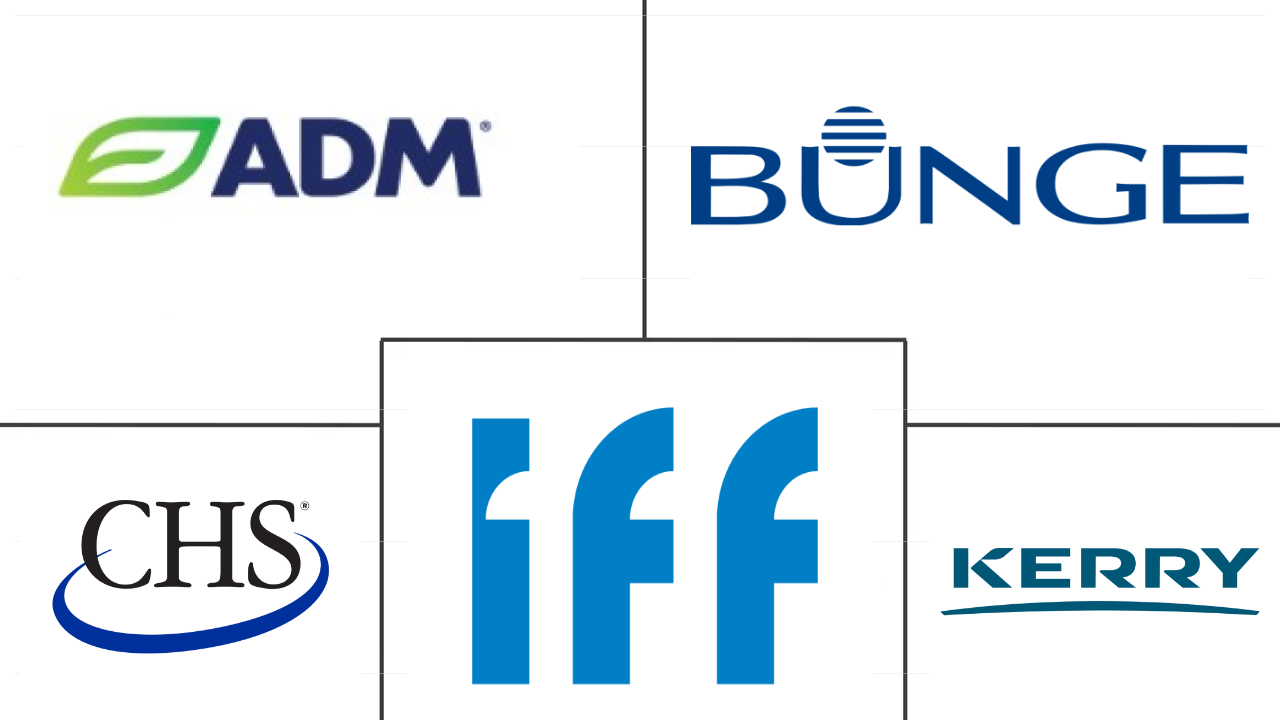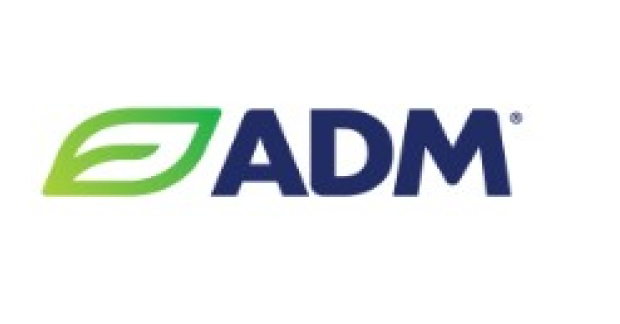Market Size of united states soy protein Industry
|
|
Study Period | 2017 - 2029 |
|
|
Market Size (2024) | USD 2.87 Billion |
|
|
Market Size (2029) | USD 3.44 Billion |
|
|
Largest Share by End User | Food and Beverages |
|
|
CAGR (2024 - 2029) | 3.72 % |
|
|
Fastest Growing by End User | Supplements |
Major Players |
||

|
||
|
*Disclaimer: Major Players sorted in no particular order |
United States Soy Protein Market Analysis
The United States Soy Protein Market size is estimated at 2.87 billion USD in 2024, and is expected to reach 3.44 billion USD by 2029, growing at a CAGR of 3.72% during the forecast period (2024-2029).
2.87 Billion
Market Size in 2024 (USD)
3.44 Billion
Market Size in 2029 (USD)
5.82 %
CAGR (2017-2023)
3.72 %
CAGR (2024-2029)
Largest Market by Form
43.19 %
value share, Isolates, 2023
Soy protein isolates overpower other forms owing to its low viscosity, high dispersibilty and solublilty, that caters to its extensive application in all the sectors.
Largest Market by End User
51.39 %
value share, Food and Beverages, 2023
The F&B sector, closely followed by the animal feed sector, is leading the end-user segment, primarily due to the demand from the dairy and meat alternatives sectors.
Fastest Growing Market by Form
4.25 %
Projected CAGR, Isolates, 2024-2029
Constant research studies and innovations, mainly in the field of animal feed, are supporting the application of soy protein isolates, which may drive the segment.
Fastest Growing Market by End User
6.28 %
Projected CAGR, Supplements, 2024-2029
The growing consumer focus on health and sports fitness may drive the segment. Due to its high protein content, soy is the most preferred protein source in the sector.
Leading Market Player
16.40 %
market share, Archer Daniels Midland Company, 2021

Archer Daniels Midland Company holds the largest share of the market. The company has collaborated with regional clients as an expansion strategy, to expand its consumer base.
Food and Beverages sector accounted major share in usage of soy protein due to growing vegan population coupled with nutritional properties associated with soy protein
- The food and beverages sector registered the highest demand, with the overall sales value increasing by 49.7% in 2022 since 2016. Due to their functional and nutritional properties, they are utilized in a variety of food applications such as baking, confectionary, emulsion-type sausages, dairy replacers, functional beverages, nutritious bars, and breakfast cereals. These properties include fat and water absorption, emulsification, and whipping. Soy proteins are among the most preferred meat and dairy protein substitutes, which has helped food manufacturers control prices and enhance product profitability.
- As the most economical plant protein alternative for Americans consuming vegetarian diets, the demand for soy proteins spiked across the food and beverages sector. In the food and beverages sector, the demand for soy proteins is led by the meat/meat alternative industry, owing to its functionalities that mimic the muscle texture when layered into linear fibers. Consumers are increasingly opting for plant-based proteins like soy due to rising awareness of animal cruelty and the detrimental impacts that animal-based proteins have on the environment.
- The growth of supplements is aided by the sports and performance nutrition sub-segment, which was the fastest-growing sub-segment, recording a CAGR of 7.18% during the forecast period. Soy proteins are extensively preferred by female athletes, owing to their benefits in conditions such as Female Athlete Triad Syndrome (FATS). For female athletes, soy protein powder is frequently used as an ergogenic aid to enhance performance and speed up muscle recovery, which can help with osteoporosis.
United States Soy Protein Industry Segmentation
Concentrates, Isolates, Textured/Hydrolyzed are covered as segments by Form. Animal Feed, Food and Beverages, Supplements are covered as segments by End User.
- The food and beverages sector registered the highest demand, with the overall sales value increasing by 49.7% in 2022 since 2016. Due to their functional and nutritional properties, they are utilized in a variety of food applications such as baking, confectionary, emulsion-type sausages, dairy replacers, functional beverages, nutritious bars, and breakfast cereals. These properties include fat and water absorption, emulsification, and whipping. Soy proteins are among the most preferred meat and dairy protein substitutes, which has helped food manufacturers control prices and enhance product profitability.
- As the most economical plant protein alternative for Americans consuming vegetarian diets, the demand for soy proteins spiked across the food and beverages sector. In the food and beverages sector, the demand for soy proteins is led by the meat/meat alternative industry, owing to its functionalities that mimic the muscle texture when layered into linear fibers. Consumers are increasingly opting for plant-based proteins like soy due to rising awareness of animal cruelty and the detrimental impacts that animal-based proteins have on the environment.
- The growth of supplements is aided by the sports and performance nutrition sub-segment, which was the fastest-growing sub-segment, recording a CAGR of 7.18% during the forecast period. Soy proteins are extensively preferred by female athletes, owing to their benefits in conditions such as Female Athlete Triad Syndrome (FATS). For female athletes, soy protein powder is frequently used as an ergogenic aid to enhance performance and speed up muscle recovery, which can help with osteoporosis.
| Form | |
| Concentrates | |
| Isolates | |
| Textured/Hydrolyzed |
| End User | ||||||||||||
| Animal Feed | ||||||||||||
| ||||||||||||
|
United States Soy Protein Market Size Summary
The United States soy protein market is experiencing a steady growth trajectory, driven by increasing consumer demand for plant-based protein alternatives. This demand is largely fueled by the rising awareness of the environmental and ethical implications of animal-based proteins, as well as the functional and nutritional benefits of soy proteins. The food and beverages sector, particularly the meat and meat alternative industry, is a significant contributor to this growth, as soy proteins are favored for their ability to mimic the texture of animal proteins. The market is also benefiting from the growing popularity of plant-based diets among younger consumers, who are more inclined to adopt vegetarian and flexitarian lifestyles. The expansion of soy protein applications in various food products, such as baking, dairy replacers, and functional beverages, further supports the market's growth.
The United States is a leading producer of soybeans, contributing significantly to global production, and this domestic supply supports both local consumption and international exports. The market is moderately consolidated, with major players like Archer Daniels Midland Company, Bunge Limited, and CHS Inc. dominating the landscape. These companies are actively involved in innovations and expansions to meet the growing demand for soy-based ingredients. The market's growth is also supported by strategic initiatives from organizations like the United Soybean Board, which promotes best practices in soybean farming. Additionally, the development of new soy-based products and ingredients, such as DuPont's Danisco Planit range and Protein Nuggets, highlights the ongoing innovation within the industry, catering to the increasing consumer preference for plant-based food and beverages.
United States Soy Protein Market Size - Table of Contents
-
1. MARKET SEGMENTATION (includes market size in Value in USD and Volume, Forecasts up to 2029 and analysis of growth prospects)
-
1.1 Form
-
1.1.1 Concentrates
-
1.1.2 Isolates
-
1.1.3 Textured/Hydrolyzed
-
-
1.2 End User
-
1.2.1 Animal Feed
-
1.2.2 Food and Beverages
-
1.2.2.1 By Sub End User
-
1.2.2.1.1 Bakery
-
1.2.2.1.2 Beverages
-
1.2.2.1.3 Breakfast Cereals
-
1.2.2.1.4 Condiments/Sauces
-
1.2.2.1.5 Dairy and Dairy Alternative Products
-
1.2.2.1.6 Meat/Poultry/Seafood and Meat Alternative Products
-
1.2.2.1.7 RTE/RTC Food Products
-
1.2.2.1.8 Snacks
-
-
-
1.2.3 Supplements
-
1.2.3.1 By Sub End User
-
1.2.3.1.1 Baby Food and Infant Formula
-
1.2.3.1.2 Elderly Nutrition and Medical Nutrition
-
1.2.3.1.3 Sport/Performance Nutrition
-
-
-
-
United States Soy Protein Market Size FAQs
How big is the United States Soy Protein Market?
The United States Soy Protein Market size is expected to reach USD 2.87 billion in 2024 and grow at a CAGR of 3.72% to reach USD 3.44 billion by 2029.
What is the current United States Soy Protein Market size?
In 2024, the United States Soy Protein Market size is expected to reach USD 2.87 billion.

